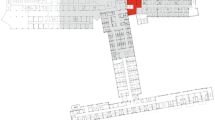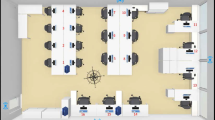Abstract
Designing an optimal indoor space is challenging in interior architecture. The optimal space design requires a comprehensive analysis of the living situation of residents in a space. However, it is extremely difficult to collect data from the space where daily life occurs. Many spatial analysis sensors are required because various daily life data must be collected precisely. Hence, it is difficult for indoor space designers to use the daily-life information of users when managing indoor layouts or floor plans. In this paper, we introduce a technique to solve this problem: simple mobile application (app) logs are used to identify the daily-life patterns of users in an indoor space, and the results are used to create the optimal space layout. We collect and process key information from the mobile app logs and Google app servers to generate a high-dimensional dataset required for user behavior analysis. Subsequently, we suggest a floor plan that minimizes the living cost using a two-dimensional genetic algorithm. Our method will facilitate the spatial analysis of currently inhabited indoor space and reduce the space utilization feedback costs of users.








Similar content being viewed by others

References
Electronics and Telecommunications Research Institute (2019) ETRI 2019 Technology Report
Lee S, Min C, Yoo C, Song J (2013) Understanding customer malling behavior in an urban shopping mall using smartphones. In: Proceedings of the 2013 ACM conference on Pervasive and ubiquitous computing adjunct publication, pp 901–910
Guo B, Wang Z, Wang P, Xin T, Zhang D, Yu Z (2020) DeepStore: Understanding Customer Behaviors in Unmanned Stores. IT Professional 22(3):55–63
Du H, Yu Z, Guo B, Han Q, Chen C (2020) GroupShop: monitoring group shopping behavior in real world using mobile devices. J Ambient Intell Humanized Comput 1–12
Mun S, Kwak Y, Huh J (2019) A case-centered behavior analysis and operation prediction of AC use in residential buildings. Energy Build 188:137–148
Ullah A, Haydarov K, Haq I, Muhammad, Khan, Rho S, Lee M, Baik S (2019) A Cluster Separation Measure. IEEE Trans Pattern Analysis Mach Intell. PAMI-1 (2):224–227
Choi J, Kim M, Byun N (2013) Quantitative analysis on the spatial configuration of Korean apartment complexes. J. Asian Architect Build Eng 12(2):277–284
Byun N, Kim M (2015) A Study on Classification of Apartment Complexes Using Spatial Analysis Technique-Focused on Pedestrian Circulation in Apartment Complex. J Architectural Inst Korea Plan & Design 31(4):61–68
Hinton G, Roweis S (2003) Stochastic neighbor embedding. In: Advances in neural information processing systems, pp 857–864
Tenenbaum J, De Silva V, Langford J (2000) A global geometric framework for nonlinear dimensionality reduction. science 290(5500):2319–2323
Saul L, Roweis S (2000) An introduction to locally linear embedding. Available at: http://www.cs.toronto.edu/roweis/lle/publications.Html
Maaten L, Hinton G (2008) Visualizing data using t-SNE. J Mach Learn Res 2579–2605
Verkasalo H (2010) Analysis of smartphone user behavior. In: 2010 Ninth International Conference on Mobile Business and 2010 Ninth Global Mobility Roundtable (ICMB-GMR), pp 258–263
Kang J, Seo S, Hong J (2011) Usage pattern analysis of smartphones. In: 2011 13th Asia-Pacific Network Operations and Management Symposium, pp 1–8
Kang J, Seo S, Hong J (2011) Collect and analyze smart phone usage patterns for mobile network management. In: Proceedings of the 13th Asia-Pacific Network Operations and Management Symposium, Taipei, Taiwan, pp 21–23
Harman M, Jia Y, Zhang Y (2012) App store mining and analysis: MSR for app stores. In: 2012 9th IEEE Working Conference on Mining Software Repositories (MSR), pp 108–111
Chaix B, Kestens Y, Perchoux C, Karusisi N, Merlo J, Labadi K (2012) An interactive mapping tool to assess individual mobility patterns in neighborhood studies. Am J Preventive Med 43(4):440–450
Kelly D, Smyth B, Caulfield B (2013) Uncovering measurements of social and demographic behavior from smartphone location data. IEEE Trans Human-Mach Syst 43(2):188–198
Hamka F, Bouwman H, De Reuver M, Kroesen M (2014) Mobile customer segmentation based on smartphone measurement. Telemat Inform 31(2):220–227
Mafrur R, Nugraha I, Choi D (2015) Modeling and discovering human behavior from smartphone sensing life-log data for identification purpose. Human-centric Comput Inform Sci 5(1):31
Jalali L, Oh H, Moazeni R, Jain R (2016) Human Behavior Analysis from Smartphone Data Streams. In: International Workshop on Human Behavior Understanding, pp 68–85
Rivron V, Khan M, Charneau S, Chrisment I (2016) Exploring smartphone application usage logs with declared sociological information. In: 2016 IEEE International Conferences on Big Data and Cloud Computing (BDCloud), Social Computing and Networking (SocialCom), Sustainable Computing and Communications (SustainCom)(BDCloud-SocialCom-SustainCom), pp 266–273
Yamamoto N, Ochiai K, Inagaki A, Fukazawa Y, Kimoto M, Kiriu K, Maeda T (2018) Physiological stress level estimation based on smartphone logs. In: 2018 Eleventh International Conference on Mobile Computing and Ubiquitous Network (ICMU), pp 1–6
Lee Y, Park I, Cho S, Choi J (2018) Smartphone user segmentation based on app usage sequence with neural networks. Telemat Inform 35(2):329–339
Fukazawa Y, Ito T, Okimura T, Yamashita Y, Maeda T, Ota J (2019) Predicting anxiety state using smartphone-based passive sensing. J Biomed inform 93:103151
Sarker I, Colman A, Han J (2019) Recencyminer: mining recency-based personalized behavior from contextual smartphone data. J Big Data 6(1):49
Yang Z, Su X (2012) Customer behavior clustering using SVM. Phys Procedia 33:1489–1496
Perdisci R, Ariu D, Giacinto G (2013) Scalable fine-grained behavioral clustering of http-based malware. Comput Netw 57(2):487–500
Bauckhage C, Sifa R, Drachen A, Thurau C, Hadiji F (2014) Beyond heatmaps: Spatio-temporal clustering using behavior-based partitioning of game levels. In: 2014 IEEE Conference on Computational Intelligence and Games, pp 1–8
Drachen A, Thurau C, Sifa R, Bauckhage C (2014) A comparison of methods for player clustering via behavioral telemetry. arXiv:1407.3950
Wang G, Zhang X, Tang S, Zheng H, Zhao B (2016) Unsupervised clickstream clustering for user behavior analysis. In: Proceedings of the 2016 CHI Conference on Human Factors in Computing Systems, pp 225–236
Farhan A, Lu J, Bi J, Russell A, Wang B, Bamis A (2016) Multi-view bi-clustering to identify smartphone sensing features indicative of depression. In: 2016 IEEE First International Conference on Connected Health: Applications, Systems and Engineering Technologies (CHASE), pp 264–273
De Leoni M, van der Aalst W, Dees M (2016) A general process mining framework for correlating, predicting and clustering dynamic behavior based on event logs. Inform Syst 56:235–257
Peach R, Yaliraki S, Lefevre D, Barahona M (2019) Data-driven unsupervised clustering of online learner behaviour. NPJ Sci Learn 4(1):1–11
Simonyan K, Zisserman A (2014) Very deep convolutional networks for large-scale image recognition. arXiv:1409.1556
Lawrence S, Giles C, Tsoi A, Back A (1997) Face recognition: A convolutional neural-network approach. IEEE Trans Neural Netw 8(1):98–113
Casale P, Pujol O, Radeva P (2011) Human Activity Recognition from Accelerometer Data Using a Wearable Device. In: Proceedings of Pattern Recognition and Image Analysis, pp 289–296
Fujimoto T, Nakajima H, Tsuchiya N, Marukawa H, Kuramoto k, Kobashi S, Hata Y (2013) Wearable Human Activity Recognition by Electrocardiograph and Accelerometer. In: 2013 IEEE 43rd International Symposium on Multiple-Valued Logic, IEEE
Ann O (2014) Lau B (2014) Human activity recognition: A review, 4th IEEE International Conference on Control System. Computing and Engineering, ICCSCE
Ke S, Thuc H, Lee Y, Hwang J, Yoo J, Choi K (2013) a review on video-based human activity recognition. Computers 2(2):88–131
Chan M, Esteve D, Escriba C, Campo E (2008) A Review of Smart Homes-Present State and Future Challenges. J Comput Methods Prog Biomed 91(1):55–81
Singh D, Merdivan E, Psychoula I, Kropf J, Hanke S, Geist M, Holzinger A (2018) Human Activity Recognition using Recurrent Neural Networks, pp 267–274. arXiv:1804.07144
Fallmann S, Kropf J (2016) Human activity recognition of continuous data using Hidden Markov Models and the aspect of including discrete data. In: 2016 Intl IEEE Conferences, pp 121–126
Li Q, Zheng Y, Xie X, Chen Y, Liu W (2008) Ma W (2008) Mining User Similarity Based on Location History. In: Proceedings of the 16th ACM SIGSPATIAL international conference on Advances in geographic information systems, pp 1–10
Kang S, Kim S (2021) Behavior analysis method for indoor environment based on app usage mining. J Supercomput 1–21
Kang S, Kim Y, Park T, Kim C (2013) Automatic player behavior analysis system using trajectory data in a massive multiplayer online game. Multimed Tools Appl 66(3):383–404
Wang T, Wong D (1991) An optimal algorithm for floorplan area optimization. In: Proceedings of the 27th ACM/IEEE Design Automation Conference, pp 180–186
Rebaudengo M, Reorda M (1996) GALLO: A genetic algorithm for floorplan area optimization. IEEE Trans Comput-Aided Design of Integrated Circuits and Systems 15(8):943–951
Wang T, Wong D (1992) Optimal floorplan area optimization. IEEE Transactions on Computer-Aided Design of Integrated Circuits and Systems 11(8):992–1002
Michalek J, Choudhary R, Papalambros P (2002) Architectural layout design optimization. Engineering optimization 34(5):461–484
Rodrigues E (2014) Automated floor plan design: generation, simulation, and optimization (Doctoral dissertation)
Dogan T, Saratsis E, Reinhart C (2015) The optimization potential of floor-plan typologies in early design energy modeling. In: Proceedings of BS2015: 14th Conference of International Building Performance Simulation Association, Hyderabad, India, Dec
Zawidzki M, Szklarski J (2020) Multi-objective optimization of the floor plan of a single story family house considering position and orientation. Advances in Engineering Software 141:102766
Pentland A, Liu A (1999) Modeling and prediction of human behavior. Neural computation 11(1):229–242
Applegate D, Bixby R, Chvátal V, Cook W (2011) The traveling salesman problem. Princeton university press
Olivier I, Smith D, and Holland J (1987) A study of permutation crossover operators on the travelling salesman problem. In: Proceeding Second International Conference on Genetic Algorithms, pp 224–230
Goldberg D, Lingle R (1985) Alleles, loci, and the traveling salesman problem. In: Proceedings of International Conference on Genetic Algorithms and their Applications, pp 154–159
Whitley L, Starkweather T, Fuquay D (1989) Scheduling problems and traveling salesmen: the genetic edge recombination operator. ICGA, pp 133–140
Yun Y, Moon C (2011) Genetic algorithm approach for precedence-constrained sequencing problems. Journal of Intelligent Manufacturing 22(3):379–388
Poon P, Carter J (1995) Genetic algorithm crossover operators for ordering applications. Computers & Operations Research 22(1):135–147
Seo D, Moon B (2002) Voronoi Quantizied Crossover For Traveling Salesman Problem. In: GECCO, pp 544–552
Hopper E, Turton B (1999) A genetic algorithm for a 2D industrial packing problem. Computers & Industrial Engineering 37(1–2):375–378
Author information
Authors and Affiliations
Corresponding author
Additional information
Publisher's Note
Springer Nature remains neutral with regard to jurisdictional claims in published maps and institutional affiliations.
Rights and permissions
About this article
Cite this article
Kang, S., Kim, S.K. Floor plan optimization for indoor environment based on multimodal data. J Supercomput 78, 2724–2743 (2022). https://doi.org/10.1007/s11227-021-03952-9
Accepted:
Published:
Issue Date:
DOI: https://doi.org/10.1007/s11227-021-03952-9



